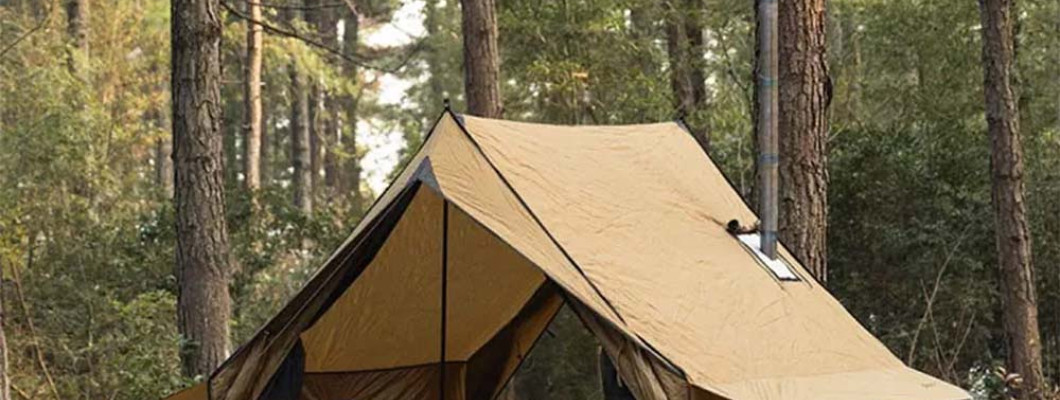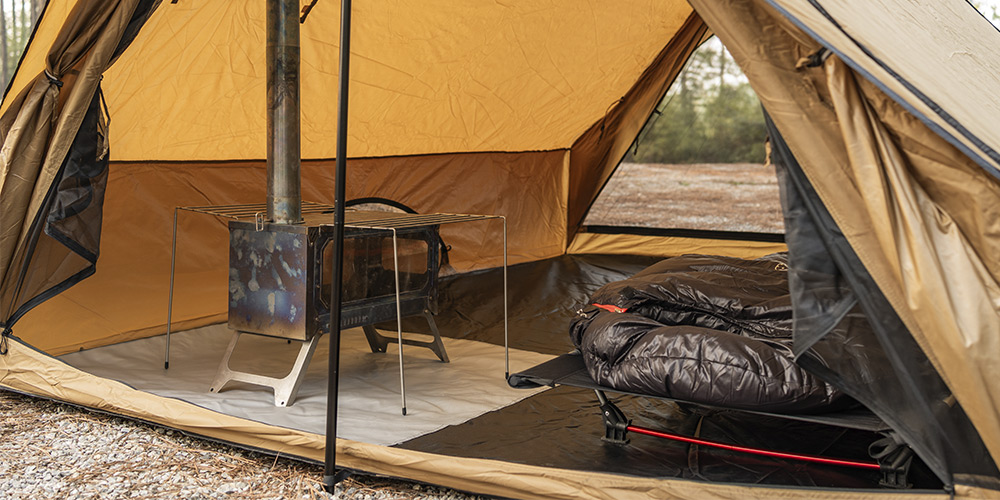
New Zealand’s breathtaking landscapes are a dream for outdoor enthusiasts, offering everything from serene beaches to towering mountains. While much of the country enjoys a mild winter, certain regions, particularly in the South Island, are transformed into a pristine snowy wonderland as temperatures drop. For those daring enough to embrace the cold, hot tenting provides a unique opportunity to explore these frozen landscapes while staying warm and cozy in subzero temperatures.
This beginner’s guide will walk you through everything you need to know to get started with hot tenting in New Zealand’s winter wilderness.
Understanding Hot Tenting
Hot tenting is more than just camping in cold weather—it's an art form that blends traditional camping with the comforts of warmth and shelter. Essentially, hot tenting involves setting up a tent equipped with a wood stove, allowing campers to generate heat inside their tent even in the harshest of winter conditions. This setup not only provides warmth but also creates a comfortable living space where you can dry wet gear, cook meals, and relax without battling the biting cold.
In New Zealand, where winter can be both beautiful and brutal, hot tenting has gained popularity as a way to extend the camping season year-round. With the right gear and preparation, hot tenting enables adventurers to enjoy the snowy outdoors while staying protected from the elements.

Why New Zealand is Perfect for Hot Tenting
New Zealand’s winter landscapes are nothing short of spectacular. From the snow-capped peaks of the Southern Alps to the icy beauty of Tongariro National Park, the country offers a diverse range of environments perfect for winter camping. Hot tenting allows you to immerse yourself in these remote locations, experiencing the serene beauty of snow-covered wilderness without the discomfort of freezing temperatures.
Popular hot tenting locations include:
- Tongariro National Park: Known for its rugged volcanic terrain and stunning alpine scenery, this park offers a challenging yet rewarding hot tenting experience.
- Southern Alps: Stretching across the South Island, the Southern Alps provide numerous spots for hot tenting, with breathtaking views and varying levels of difficulty.
- Fiordland: Renowned for its dramatic landscapes and secluded spots, Fiordland is ideal for those looking to combine hot tenting with some of New Zealand’s most iconic hikes.
These regions present unique challenges, such as deep snow, high winds, and rapidly changing weather, making hot tenting an attractive option for staying warm and safe.
Choosing the Right Hot Tent for New Zealand's Winter
Selecting the right hot tent is crucial for a successful winter camping experience in New Zealand. The key factors to consider include the tent's material, size, and stove compatibility.
- Material: Look for tents made from durable, weather-resistant materials such as canvas, which offers excellent insulation and breathability. Canvas tents are also less prone to condensation, making them ideal for the damp, cold conditions found in New Zealand’s winters.
- Size: Choose a tent size that suits your group and camping style. Larger tents offer more space for gear and stove setup, but they also require more effort to heat. For solo or duo camping, a smaller tent is more efficient.
- Stove Compatibility: Ensure your tent is compatible with a wood stove. Many hot tents come with a built-in stove jack (an opening for the stove pipe), which is essential for safely venting smoke out of the tent.
Some recommended hot tents for New Zealand’s winter include the Naturehike Ares Hot Tent, which is lightweight and compact, and the Pomoly Chalet 70 Pro, known for its robust construction and excellent insulation.
For two people, consider the Pomoly Locomotive 2-Person Tent, which provides ample space and a sturdy setup for challenging winter conditions.
Essential Gear for Hot Tenting in New Zealand
Hot tenting requires a specific set of gear to ensure comfort and safety in subzero temperatures. Here’s a detailed list of must-have items:
- Sleeping Bag: Opt for a high-quality, four-season sleeping bag rated for subzero temperatures. Down sleeping bags are lightweight and provide superior warmth, but synthetic options are also available for those who prefer a lower price point or better moisture resistance.
- Insulation Layers: In addition to your sleeping bag, bring insulated sleeping pads and extra blankets to provide an additional barrier between you and the cold ground. These layers will help trap heat and prevent cold spots.
- Wood Stove: A wood stove is the heart of your hot tenting setup. Choose a portable stove designed for camping, such as the Thous Winds Ultralight Titanium Stove or the Naturehike Titanium Tent Wood Stove, both known for their efficiency and lightweight construction.
- Cooking Equipment: Bring cookware that is compatible with your stove, such as pots, pans, and a kettle. The Portable Ultralight Camp Oven Stove is a versatile option that can handle high temperatures and allows you to bake as well as cook.
- Lighting: Winter nights are long, so pack headlamps, lanterns, and spare batteries to keep your tent well-lit. Solar-powered lanterns are a great eco-friendly option.
- Fire Starting Kit: Ensure you have a reliable way to start a fire, such as waterproof matches, a lighter, and fire starters. Consider bringing a backup method, like a ferrocerium rod, for emergencies.
Additionally, accessories like the Hot Tent Stove Chimney Fireproof Ribbon and a Stove Chimney Damper can enhance your setup by improving safety and heat control.
Quality gear is essential for staying warm and safe during hot tenting in New Zealand’s challenging winter conditions. Don’t skimp on these items, as they can make or break your experience.
How to Safely Set Up a Hot Tent in New Zealand's Snowy Terrain
Setting up a hot tent in snowy or icy terrain requires careful planning and execution. Follow these steps for a safe and effective setup:
- Site Selection: Choose a flat, sheltered location away from avalanche zones and wind-exposed areas. Look for natural windbreaks like trees or rocks to help protect your tent from strong gusts.
- Snow Preparation: If the snow is deep, compact it to create a stable base for your tent. This can be done by stomping on the snow with your boots or using snowshoes. A firm surface will prevent your tent from sinking or shifting during the night.
- Pitching the Tent: Erect your tent according to the manufacturer’s instructions, ensuring that it is taut and secure. Use snow stakes or deadman anchors (objects buried in the snow) to hold the tent in place, as traditional stakes may not hold in deep snow.
- Stove Setup: Once the tent is up, position your wood stove on a fireproof mat inside the tent. Ensure the stove pipe is securely attached and vents through the stove jack. Test the stove to make sure it draws properly and that there is no smoke leakage inside the tent.
- Ventilation: Proper ventilation is crucial to prevent carbon monoxide buildup. Keep a small vent open, even when the stove is burning, to allow fresh air to circulate.
Taking the time to set up your hot tent correctly will pay off in warmth, comfort, and safety during your winter camping adventure.
Staying Warm: Tips and Tricks for Hot Tenting in Subzero Temperatures
Maintaining warmth in subzero temperatures is the primary challenge of hot tenting. Here are some strategies to help you stay toasty inside your tent:
- Efficient Stove Use: Start by lighting your wood stove as soon as you arrive at camp to begin heating the tent. Use dry, seasoned wood for a hotter, longer-lasting fire. Once the stove is burning steadily, regulate the airflow to maintain a consistent temperature.
- Clothing Layers: Dress in layers that you can easily add or remove as needed. Begin with moisture-wicking base layers, followed by insulating mid-layers, and finish with a windproof and waterproof outer shell. Avoid cotton, as it retains moisture and can lead to hypothermia.
- Heat Retention: Use heat-reflective blankets or tarps to line the walls of your tent, which will help retain warmth. Sleeping with a hot water bottle can also provide additional warmth inside your sleeping bag.
- Movement: If you start feeling cold, do some light exercises like jumping jacks or jogging in place to boost your circulation. This will help warm you up quickly.
By following these tips, you’ll be able to create a warm and comfortable environment inside your hot tent, even when the temperatures outside are well below freezing.
Managing Condensation and Moisture in New Zealand's Wet Winter Climate
Condensation can be a significant issue when hot tenting in New Zealand’s wet and cold climate. Excess moisture can lead to damp gear, which is not only uncomfortable but also dangerous in freezing conditions. Here’s how to manage it:
- Ventilation: Always keep a small vent open, even when the stove is burning, to allow moisture to escape. Proper ventilation is key to reducing condensation buildup inside the tent.
- Drying Wet Gear: Use the heat from your stove to dry wet clothing and gear. Hang items on a drying line or rack near the stove, but be careful not to place them too close to avoid scorching or melting.
- Managing Snow and Ice: When entering your tent, knock off as much snow and ice from your boots and gear as possible. This prevents extra moisture from entering the tent and contributing to condensation.
- Floor Protection: Use a groundsheet or tarp to create a barrier between the tent floor and the snow or ice beneath. This helps to reduce the amount of moisture that seeps into the tent from below.
Conclusion
Hot tenting in New Zealand offers a remarkable way to experience the country's diverse winter landscapes. By carefully selecting the right gear, understanding the nuances of setup, and following best practices for staying warm, even the coldest nights can be made comfortable and enjoyable. Whether you're an experienced camper looking to extend your adventures into the winter months or a beginner eager to explore New Zealand's winter wilderness, hot tenting provides the perfect balance of challenge and comfort. Embrace the cold, and discover the beauty of New Zealand in its quietest, most serene season.
For those ready to take the plunge, make sure you're equipped with the right gear to ensure a safe and memorable experience. Explore top-quality Hot Tents and Stoves for Winter Camping and start planning your next adventure today!

Leave a Comment